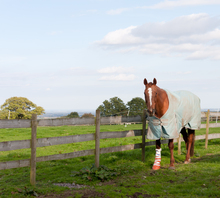According to Mark Russell, assistant professor in the Equine Extension at the University of Arkansas Division of agriculture, horses with very short hair may be the only horses that need to be blanketed during winter weather. In fact , a blanket may not be the best thing for horses kept outside in winter, especially when it’s wet.

Cold weather protection for horses
A damp or wet blanket draped over a horse in the cold can do much more harm than it could ever do good, but in extremely cold conditions, any type of horse may need a winter blanket.
“When it's wet and cold like this, it's OK for a horse to be in a pasture,” Russell said. “They were intended to be outside.” Horses generate lots of heat, kept in by their coats.
“As long as the horse has grown its winter hair, it doesn’t need to wear a blanket outside,” he said, adding that blanketing can backfire. “The blanket actually pushes the hair down, compressing the air spaces and the hair isn't able to insulate the way it's intended.”
And for anyone who has to keep horse clothing clean knows, “it takes a long time for a winter blanket or sheet to dry and anything damp draped over a horse in the cold like that can do much more harm than it could ever do good,” he said. “Horses grow winter hair for a reason and it's their natural way of keeping warm.”
When deciding if a horse blanket is right for your horse, the most important things to consider are the horses living situation and daily tasks.
The easiest way to tell if your horse needs a winter blanket is to observe him in cold temperatures. Is he shivering? If so, he needs a winter blanket.
If your horse is a backyard trail horse, with a protective shed and a full coat in the winter, you may not need a blanket at all. Typically, horses in these situations will do fine with their own coat for protection against the elements. The only exception would be if you live in a climate with extreme temperatures. In these cases, your horse may need a winter blanket.
Winter blankets are the thickest, warmest horse blanket made and are comparable to a winter coat for a person. In extremely cold conditions, any type of horse may need a winter blanket, whether stalled or in the pasture with a shelter.
If you do blanket him, make sure to remove the blanket when the temperature warms up. It is harmful to your horse for him to be too cold, but being overly hot is also dangerous. To check, periodically run your hand underneath your horse’s winter blanket. If your horse is sweating, it’s time for a lighter blanket or none at all.
For show horses that have their bodies shaved regularly, completely different rules apply. These horses likely need some type of blanket. Shaving a horse’s normal coat leaves it defenseless against many outside elements and the right blanket can help you compensate for this.
A turnout blanket will be needed if you own a show horse that is regularly clipped. Turnout blankets are made of heavy-duty material and can be worn in cold or warm temperatures. Turnout blankets are dual purpose, offering protection from cold in low temperatures and sunburn in the summer. Use the same principle as with winter blankets - don’t leave a turnout blanket on your horse if he is sweating or gets wet.
Note: This still timely article was first posted on EquiMed in 2014.
Press release by Equine Extension at the University of Arkansas Division of Agriculture
